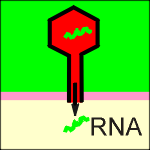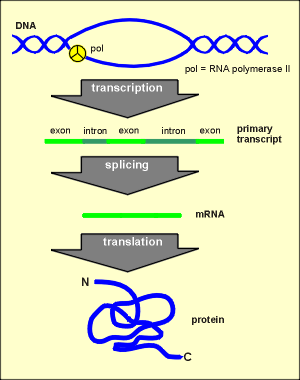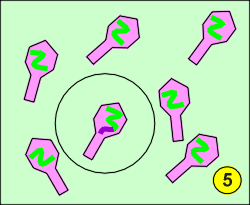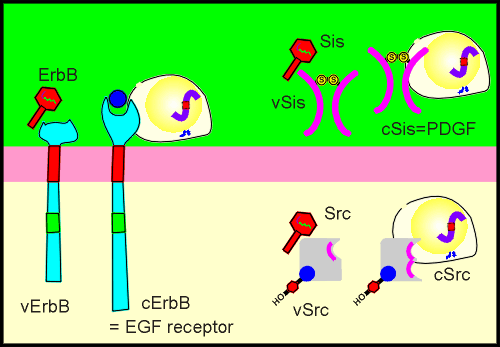 Oncogenes
are tumor-inducing genes of retroviruses.
Oncogenes
are tumor-inducing genes of retroviruses.  Oncogenes
are tumor-inducing genes of retroviruses.
Oncogenes
are tumor-inducing genes of retroviruses.
A number of protein products of oncogenes have been found to have high homology to proteins involved in tyrosine kinase receptor signaling.
Therefore the module Oncogenes has been included in this tutorial on tyrosine kinase receptors.
 There
are two pieces of evidence that oncogenes were originally from the eucaryotic genome.
There
are two pieces of evidence that oncogenes were originally from the eucaryotic genome.
The first piece of evidence is that oncogenes code for products that have high sequence homology to products of the eucaryotic genome (e.g. vSrc and cSrc).
The second piece of evidence is that oncogenes have an exon-intron structure.
Exon-intron structure in the genome is a property of eucaryotic cells, not of bacteria and viruses.
The primary RNA transcript in eucaryotic gene expression consists of exons and introns.
The exons are cut out and spliced together to make the mature mRNA.
The presence of exons and introns in oncogenes gave rise to the idea that oncogenes were originally genes of the eucaryotic genome that have been "taken over" by retroviruses.
How could this occur?......take a look at the 10-step scenario!
 .
. .
.
A retrovirus infects a eucaryotic cell (1). The RNA is transcribed to DNA by reverse transcriptase, RT(2). The DNA is then incorporated into the host genome.
Note that the host has a gene, X, which makes a small amount of a regulatory protein X (perhaps X is an enzyme, or a receptor or a G protein).

 The DNA is transcribed back to RNA
to make new viral particles (4). During one of the transcription events a mistake
occurs.......part or all of host gene X is transcribed!
The DNA is transcribed back to RNA
to make new viral particles (4). During one of the transcription events a mistake
occurs.......part or all of host gene X is transcribed!
Now we have a virus with genetic material coding for part or all of gene X (5).
This virus carries a potential oncogene. Perhaps crucial "regulatory domains" of X are missing in the part of the gene that the virus has aquired. Or, perhaps during many new infections (and thus many reverse translation and translation events) mistakes occur resulting in a mutated form of protein X.
.
 .
. .
.
Now we have a new infection (6). The viral RNA (including that region coding for X) is transcribed into DNA (7). The DNA is incorporated into the host genome (8) and now we have a potential problem....a gene coding for X and a viral gene coding for something that has a high homology to X.

 The viral gene X
produces a massive amount of regulatory protein X (perhaps something is wrong with the
promoter of the gene) or........
The viral gene X
produces a massive amount of regulatory protein X (perhaps something is wrong with the
promoter of the gene) or........
Viral gene X produces a form of protein X that is constitutively (i.e. always) active!
The result is the same, neoplastic transformation and cancer (10).
The viral gene is now called an oncogene. It is the oncogene for vX (viral X protein).
The host gene for X is called a proto-oncogene. The product of this gene is now termed cX (cellular X protein) to distinguish it from the viral product.
 Shown
on the right are some retroviruses, their oncogene products, together with their cellular
equivalents.
Shown
on the right are some retroviruses, their oncogene products, together with their cellular
equivalents.
The ErbB oncogene codes for a membrane-bound tyrosine kinase with high sequence homology to the receptor for Epidermal Growth Factor (EGF).
vErbB lacks the ligand binding domain of the EGF receptor and it is missing a piece on the C-terminal.
vErbB is constitutively active, thus accounting for the cancer-inducing action of the ErbB virus.
The Sis oncogene codes for a product that is almost identical to platelet drived growth factor (PDGF).
vSIS is made and released in massive amounts, thus accounting for the oncogenic (tumor-inducing) behavior of the vSIS gene.
vSrc is a cytosolic tyrosine kinase that is expressed at high levels in infected cells.
The cSrc proto-oncogene was the first proto-oncogene to be discovered.
The next module of this tutorial will introduce you to the Trk oncogene, an oncogene found in a human colon carcinoma.
Research on the Trk oncogene led to the discouvery of tyrosine kinase receptors in the brain.